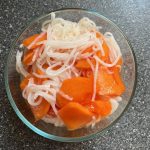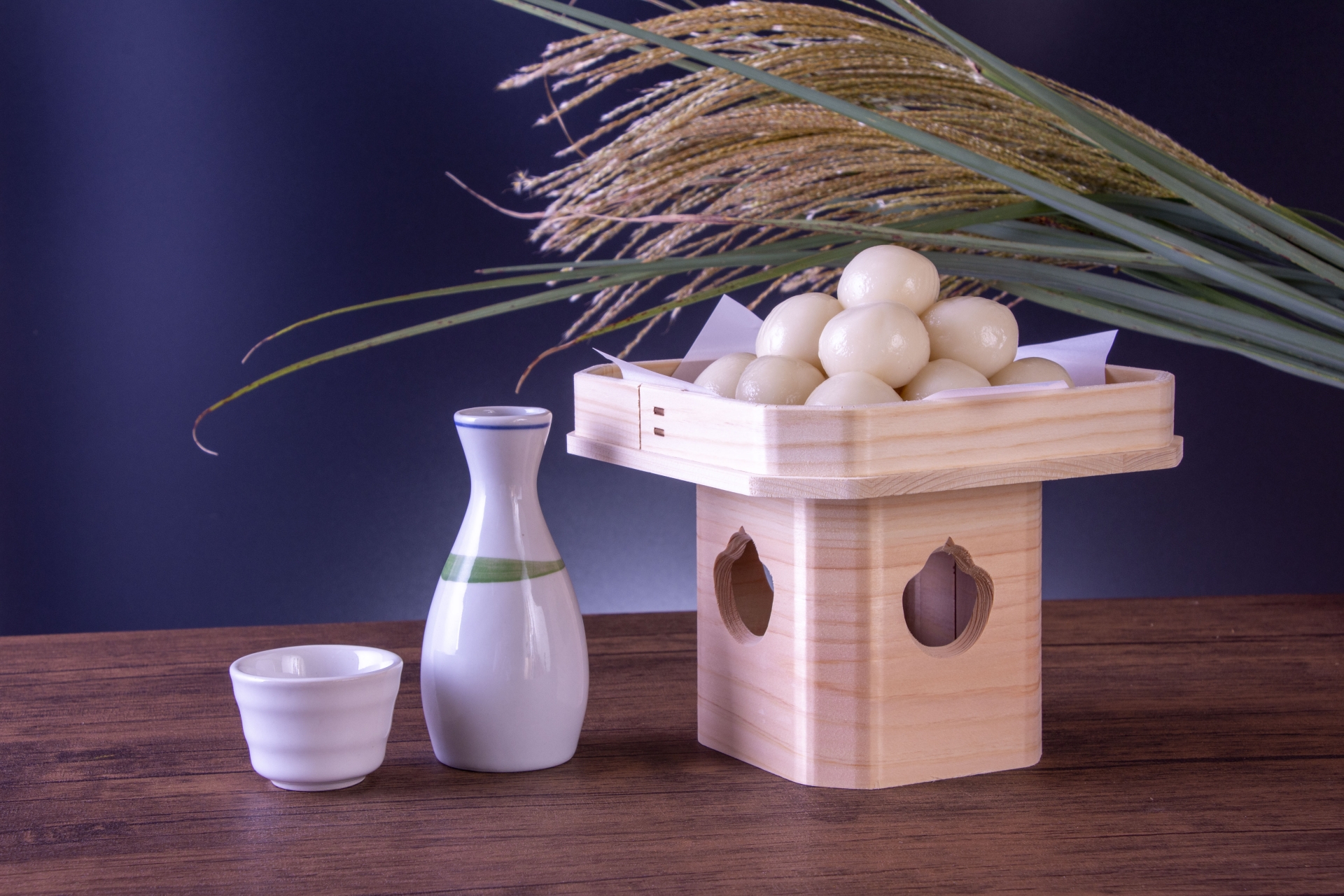和訳は英文の後にございます。/ The Japanese translation is below the English text.
Contents
1. Astringent persimmons
2. The two varieties
3. Finding a sweeter non-astringent persimmon
4. How to remove astringency at home
(1) When your persimmon is already cut
(2) When the persimmons are intact
(3) Some situations with persimmons in Japan
5. A recipe: Kaki Namasu (Daikon and Persimmon Salad)
1. Astringent persimmons
At a supermarket, the bright orange color of persimmon fruit delighted me.
Persimmons are an ancient fruit native to East Asia. You just peel it and eat it fresh, and the fruit is as smooth as strawberries and mangoes to the palate, sweet, and delicious. It’s the taste of late fall to early winter.
I bought three large persimmons and brought them home. I peeled one and bit into a piece.
“Oh, no, this is a shibu-gaki! Phooey! Phooey!”
I took it out from my mouth in dismay. It was astringent for me and I couldn’t eat it.
“Shibu-gaki” means “astringent persimmon”. With persimmons, we say “astringent” (or “shibui” in Japanese) when you feel something like dry, coarse flour spread and stick all over the inside your mouth. Some think it resembles bitterness. Anyway, it’s an unpleasant sensation.
The astringency is due to tannin contained in every persimmon. The form of the tannin, however, water soluble or insoluble, decides its taste. If the tannin is water soluble, the persimmon is astringent; and if the tannin is insoluble, it is non-astringent and so suitable for eating fresh.
In Japan, only ready-to-eat persimmons are commonly sold at supermarkets. It means only available are either non-astringent persimmons or astringent persimmons from which the astringency is completely removed.
In several supermarkets of South Carolina and New York, astringent persimmons are sold without warning or information for customers and we are a little apprehensive. We would not like to disappoint and scare new customers away! There are ways to eat astringent ones; the non-astringent ones are easy to eat and tasty; and all persimmons are very nutritious. Besides tannin, an anti-oxidant, they are rich in Vitamin C, Beta carotene, potassium and dietary fiber.
2. The two varieties
The persimmon was introduced to the US in mid-19th Century from Japan. Now, American farmers are growing many varieties, of which two varieties you see most often in the supermarkets.
One is the smaller, flat-shaped “Fuyu-gaki”, which is ready to eat. “Fuyu” is a representative of non-astringent varieties that we call “ama-gaki”, sweet persimmon, in Japanese.
The other is the bell-shaped “Hachiya-gaki”. Remember, these are astringent. “Hachiya” is the representative of the varieties called “shibu-gaki”, astringent persimmon. “Hachiya”, however, has much higher sugar content than “Fuyu”, so we will tell you how we remove the astringency in Section 4.
As I recall, the Hachiya Persimmons that I bought had been somewhat treated for tannin, but I can’t bear with any tannin taste in persimmons. If you are like me, taste a little before you eat, and if there is any tannin left, please refer to Section 4.
3. Finding a sweeter non-astringent persimmon
Assuming you pick a non-astringent persimmon, is there a way to increase the chance of hitting a sweeter one?
According to a persimmon orchard owner in Japan, even from the same non-astringent variety, a fruit from a pollinated tree has seeds and subsequently is sweeter and richer in taste. A fruit from a non-pollinated tree has no seeds, and a lighter taste.
If you would like to tell a persimmon without seeds from one with seeds, he advises as follows:
On the bottom or the opposite side of the calyx, the center of the fruit has a tiny black dot. If that area is slightly indented, there are no seeds in it. On the other hand, if that area slightly rises, the fruit contains seeds.
Also, if you find tiny black dots like poppy seeds scattered inside the fruit, you are lucky. People say “Persimmons with ‘sesame seeds’ are sweeter”. It is because these dots are actually tannin in the insoluble form, so it doesn’t annoy your palate.
4. How to remove astringency at home
Here are some easy ways to treat the tannin in an astringent persimmon.
(1) When your persimmon is already cut
You bake it in the oven or cook it in the microwave oven. High heat removes the astringency and turns the flesh melting soft.
We hear that in the US, people use “Hachiya” in baking bread and cake, and it stands to reason.
(2) When the persimmons are intact
1) Pour in a small bowl, a little spirit of higher alcohol content than 25% (in Japan they typically use Shoochuu, an inexpensive spirit)
2) Hold a persimmon upside down, and dip the calyx in the spirit for 10 seconds.
3) Put all the thus spirit-treated persimmons in an airtight container or in a freezer bag. Close tightly, and keep them in the refrigerator.
4) Check the taste after one week, ten days, and two weeks, and they are ready when they don’t taste astringent any more. By this time, the flesh is rather soft.
Note: I had only two persimmons to treat, so I sprinkled two tablespoons of Grand Marnier (that was the only spirit at hand) on the calyxes, didn’t wipe them off, and put them in a freezer bag before refrigerating. I left them for about three weeks, and then found them very soft, sweet, and no trace of astringency or alcohol. It didn’t smell of alcohol, either.
(3) Some situations with persimmons in Japan
In the fall, Japanese often receive persimmons from a relative or a friend who has a persimmon tree in their yard. Sometimes, the owner of the tree may give them out by the dozen and tell the recipient that their gifts are all astringent!
With this situation happening every year, people have developed many methods to remove astringency over the years.
The fanciest way is to sun-dry the persimmon so that 50% of the juice remains in the fruit. These half-sun-dried ones, called ampo-gaki in Japanese, are carefully prepared one by one and can be expensive. There are people who hang and sun-dry their persimmons from the eaves of their house, too.
At home, also, people often treat them with spirit, with heat or hot water. The simplest way is to keep them in room temperature. Eventually all astringent persimmons become non-astringent and very soft like butter.
However, Japanese generally don’t like over-ripened persimmons like that. They usually look for fruit with firm flesh at stores.
The salad in the next section is a traditional winter dish and popular in Japanese homes. Many recipe writers suggest that you use a firm persimmon so that you can enjoy the crunchiness.
However, we made this with meltingly soft “Hachiyas” and it was still delicious.
5. A recipe: Kaki-Namasu (Daikon and Persimmon Salad)
Ingredients
- Daikon, 250g or ½ lb, peeled, cut into matchsticks
- (Carrot, optional*, 125g or ¼ lb, peeled, cut into matchsticks)
- “Fuyu” or a non-astringent persimmon, 1, peeled and cut into matchsticks, or thinly sliced
- Salt, 1 teaspoon or less
Sweet vinegar mixture
Vinegar (clear colored), 2 Tablespoons
Sugar, 2/3 Tablespoons
Salt, a pinch, optional
Water, 2-3 teaspoons, if necessary
Directions
1. Sprinkle and rub salt into daikon (and carrots*) matchsticks. Leave for about 15 minutes and wring the liquid lightly. Taste. If it’s too salty, add a couple of teaspoons of water, mix, and wring again.
2. Dissolve sugar (and salt) in vinegar. Sprinkle it over the vegetable(s) and mix well.
3. Add persimmon pieces and mix. If you are using crunchy persimmons as some recommend, mix carefully since they are easily broken.
* Daikon and persimmon alone are just fine. Here I wanted to mention the possibility of carrots since the Daikon and Carrot version of this salad has the same color combination and people often make that version for the traditional dinner to celebrate the New Year. Red and white is a celebratory color scheme in Japan.
[End of the English post]
柿について少し
目次 1. 渋い柿 2. 柿の二つの種類 3. より甘い柿の見分け方 4. 自宅でできる渋抜き (1) 柿がすでに切ってあったら (2) まだ切っていない柿の場合 (3) 日本で食べる柿 5. レシピ:柿なます(柿と大根のサラダ)
1. 渋い柿
スーパーでぴかぴかのオレンジ色の柿を見つけてうれしくなりました。
柿は東アジアに古代からある果物です。皮をむいてそのまま食べると、いちごやマンゴーのような滑らかな舌触りで、甘くて、おいしい。晩秋から初冬の味です。
私は三つ大きな柿を買って家へ帰りました。一つ皮をむいて、食べてみました。
「あっ、渋柿だ! ぺっ、ぺっ」
がっかりして口から出しました。私には渋くて食べられなかったのです。
柿について「渋い」という時は、乾いたざらざらした粉のようなものが口の中一杯に広がってくっつく、そういう感じのことです。人によっては苦いような感じだといいます。とにかく、快い感触ではありません。
渋みの原因は、どの柿にも含まれているタンニンです。でも、タンニンがその柿の中で水溶性か不溶性であるかによって、味が決まります。水溶性であれば柿は渋く、不溶性であれば、渋くないのでそのまま食べるのに適しています。
日本では、普通はそのまま食べられる柿だけがスーパーに売っています。つまり、売っているのは、渋くない柿、または渋を完全に抜いた柿だけです。
南カロライナ州とニューヨークのスーパーのいくつかでは、時々渋い柿や渋抜きが完全でない柿がお客さんへの案内なしで売っていて、ちょっと心配になります。新しいお客さんをがっかりさせたり、遠ざけたりしたくない。渋い柿にも食べ方があるし、甘柿は食べやすくておいしいし、柿は栄養価が高いのです。抗酸化物質であるタンニンの他、柿はビタミンC、ベータカロテン、カリウム、食物繊維などに富んでいます。
2. 柿の二つの種類
柿の木は、19世紀の半ばに日本から米国へ導入されました。現在、米国の農家ではたくさんの品種を育てていますが、スーパーで一番よく見かけるのは次の二つです。
一つ目は、小さな、平たい「富有柿」。これは、そのまま食べられます。富有柿は日本語で「甘柿」と呼ばれる渋くない柿の代表です。
もう一つは、釣り鐘型をした「蜂屋柿」。「渋柿」の代表ですが、富有柿よりずっと糖度が高い。第四節で、渋の抜き方をお話しします。
今考えると、私が買った蜂屋柿は、ある程度渋が抜いてありましたが、私は舌に残った渋が気になりました。もしあなたも私と同じように柿渋にうるさい人だったら、食べる前に味見して、渋を感じたら、第4節をご参照ください。
3. より甘い柿の見分け方
甘柿を選ぶとき、より甘い柿の見分け方があるでしょうか?
日本のある柿農家によると、同じ甘柿の品種でも、受粉させた木の柿の実は種があって、結果的にもっと甘く味わい豊かになります。受粉させない木の実は種がなく、軽い味わいです。
スーパーで種なし(あるいは種あり)の柿を選びたい時は、次のようにします。
柿の実のお尻、またはへたの反対側の真ん中に小さな黒い点があります。その辺りがかすかにへこんでいたら、種はありません。一方、その辺りがかすかに膨らんでいたら、種があるのです。
また、果肉にケシ粒のような細かい黒い点々があったら、ラッキー!「ゴマ入りの柿は甘い」と言われます。この黒い点々は、不溶性のタンニンで、食べても感じません。
4. 自宅でできる渋抜き
ここでは、簡単な渋の処理の仕方をいくつか紹介します。
(1) 柿がすでに切ってあったら
オーブンで焼くか、電子レンジにかけます。高熱が渋を抜き、果肉はとろけるように柔らかくなります。
米国では、蜂屋柿をパンやケーキに入れて焼くと言いますが、理にかなっています。
(2) まだ切っていない柿の場合
1) 小さなボウルに25度以上のアルコールを入れます(日本では、安価な焼酎を使うことが多いです) 。
2) 柿をさかさまに持って、へたの部分をお酒に10秒漬けます。
3) こうしてアルコール処理をした柿をすべて密閉容器か冷凍用の袋に入れ、きっちり閉じて、冷蔵庫に入れます。
4) 一週間後、十日後、二週間後などに味を見て、渋さがなくなっていたら出来上がり。この時までに、果肉は柔らかくなっています。
注:私の時は柿二つだけだったので、手持ちのグランマニエ大さじ2杯をへたに振りかけて、ふき取らず、冷凍用の袋に入れて冷蔵庫に入れました。約三週間後には、とても柔らかく、甘くなっていました。渋さもアルコールも残っていませんでした。アルコールの匂いもしません。
(3) 日本で食べる柿
日本人は、秋に柿の木を持っている親戚や友人に柿をもらうことがよくあります。時には何十個ももらい、それがすべて渋柿なのです!
毎年このような状況ですから、渋柿の渋を抜くやり方が昔からいろいろ編み出されてきました。
いちばん高級なのは、果汁を50%残す形で天日で干すやり方です。この半分干した状態の柿はあんぽ柿と呼ばれ、一つ一つ念入りに作られて、高い値段で売られるものもあります。自宅の軒から柿を吊るして干し柿を作る人もいます。
また、自宅でお酒や加熱、お湯などによって渋を抜く人もいます。一番簡単なやり方は柿を室温で放っておくこと。最終的には自然に渋が抜けて室温のバターのように柔らかくなります。
しかし、日本人はそんなに熟れた柿はあまり好みません。店では硬いのを探します。
次の節でご紹介するサラダは伝統的な冬の料理で、家で簡単に作れますが、レシピの多くは、ちょっとかりっとした感じを楽しむため硬い柿を使うように指示しています。
でも、私たちはとろとろになった蜂屋柿で作ってみましたが、おいしかったです。
5. レシピ:柿なます(柿と大根のサラダ)
材料:
- 大根 250グラム、皮をむき、千六本に切る
- (好みでニンジン*1、125g、皮をむき、千六本に切る)
- 富有柿、1、皮をむき、千六本に切る、または半月の薄切りにする
- 塩、小さじ1かそれ以下
甘酢
酢(透明なもの)、大さじ2
砂糖 小さじ2
好みで塩ひとつまみ
水、小さじ2,3杯、必要な場合
作り方:
1. 大根(とニンジン[注])の細切りに塩を振り、もみ込む。15分ほどそのままにして、出てきた水分を軽く絞る。味を見て、塩から過ぎたら少し水を加え、混ぜて、また絞る。
2. 砂糖を酢に溶かす。野菜に振りかけて、よく混ぜる。
3. 柿を混ぜ込む。硬い柿を使っていたら、割れやすいのでそっと混ぜる。
[注] 大根と柿だけでよい。ニンジンの可能性を言いたかったのは、大根とニンジンの同じサラダも同じ色どりになり、このサラダが新年のおせち料理によく加わるため。紅白は日本ではお祝いごとの色。
[和文終わり]













